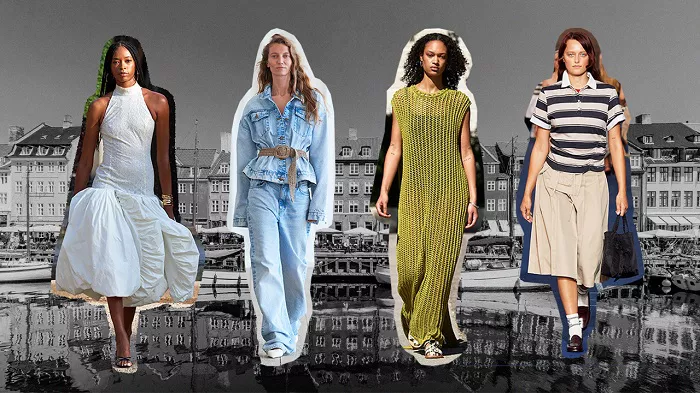Copenhagen Fashion Week (CPHFW) has shifted the fashion scene away from traditional high heels and glamorous venues, showcasing new trends that reflect the Danish capital’s unique style. Here’s a look at 10 unexpected trends emerging from the event:
1. Beyond Fancy Venues
Unlike New York Fashion Week’s plush hotels or Paris’s iconic landmarks, CPHFW attendees experienced fashion in unconventional settings. The debut show by Caro Editions took place in a car park, while Remain was presented in a former distillery. The Stel show was held atop an old coal crane. While American editors struggled with cobblestone streets in stilettos, Danish fashionistas embraced practicality with flats and bicycles. Notably, popular footwear included trail shoes from Salomon, Puma’s Speedcat OGs in red suede, and mesh ballet flats. On rainy days, locals opted for motocross high-tops or simple rubber boots instead of cowboy boots.
2. The Rise of Hipster Beverages
At CPHFW events, traditional champagne was replaced by sparkling tea served from glass teapots at Cecilie Bahnsen’s launch with Asics. Boxed water, Kronenbourg beer, and local IPA were common at shows. Evenings were spent at natural wine bars rather than exclusive clubs, with biodynamic wines from Gut Oggau topping the tables. At the Rotate after-party, guests enjoyed boozy, bright orange slushies.
3. The Bandana Revival
The bandana made a strong comeback, appearing everywhere from wrapped around heads to layered over and under caps. This 90s accessory was a prominent trend at the shows. Models at Caro Editions wore fold-over brim hats in contrasting fabrics like leopard print and polka dots, reflecting the widespread adoption of this trend.
4. Fruity Décor
Copenhagen’s events featured abundant fruit displays. At La Bagatelle, cherries were served on antique delftware, while Locale 21 served them from giant silver bowls. Tekla showcased polished plums, COS displayed peas in pods, and Sophie Bille Brahe’s showroom featured apricots on vintage plates.
5. Charms on Bags
Bag charms became a major trend, with vintage bags like Balenciaga’s City and Louis Vuitton Speedys decorated with plush teddy bears, tassels, and holiday souvenirs. The more eclectic and quirky the charms, the better.
6. Perfect Pastries
Danish bakeries stuck to their traditional style with bite-sized carrot cakes and mini banana bread loaves. Andersen & Maillard’s cube-shaped croissants filled with strawberry jam and cream cheese were a hit, while Juno’s rounded buns topped with blackcurrant were also popular.
7. Supersized Scrunchies
The accessory of choice was the oversized scrunchie, which became more popular than claw clips. These scrunchies, as large as small tea saucers, were seen on low buns and became a staple at fashion-insider favorite Pico. Silk versions and flower-shaped rosettes were particularly sought after.
8. Flat White Fatigue
Danish fashionistas prefer a sit-and-sip coffee culture. La Cabra, located at AnotherAspect, serves drip coffee, while iced matcha is also popular. Many locals avoid caffeine, with Sonny offering golden lattes made with oat milk, turmeric, and fresh cinnamon.
9. Day-to-Night Pajamas
Tekla Fabrics turned pajamas into daywear, with their sateen PJ sets being worn casually. The fabric, with a subtle gloss, was seen paired with denim and other daywear. Mandiberg’s striped cotton PJ pants were worn with shirts, and Hay Stores’ two-tone pajama sets were used for both day and night outfits.
10. Cross-Pollination Dressing
Danish fashion blends different styles effortlessly. Coquette elements like broderie anglaise tops and ribboned cardigans were combined with athletic shorts. Casual jorts were upgraded with boardroom-ready knitted tops and kitten heels. Sheer skirts were worn over jeans, and sequined dresses were layered with crisp shirts. Striped rugby tops clashed with crochet knits and tailored outfits, showcasing the versatility of Danish fashion.
Related topics:
- Geographic Limitations Hinder Effectiveness Of Eco-Friendly Clothing Return Schemes
- Copenhagen Fashion Week: A Celebration Of Women Designers
- Scottsdale Fashion Week Announces Casting Calls For Upcoming Event

